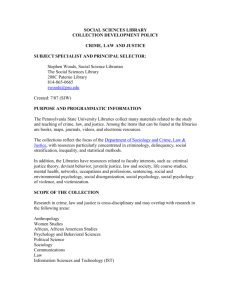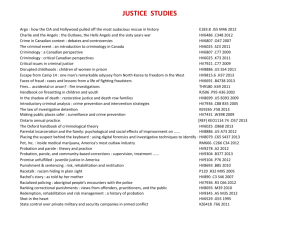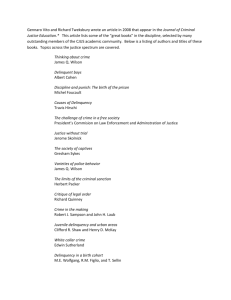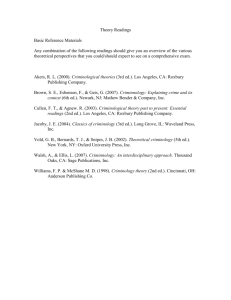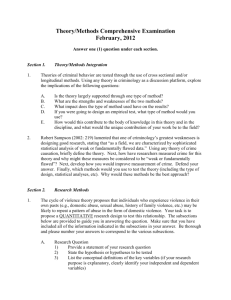CALIFORNIA STATE UNIVERSITY, LONG BEACH
advertisement
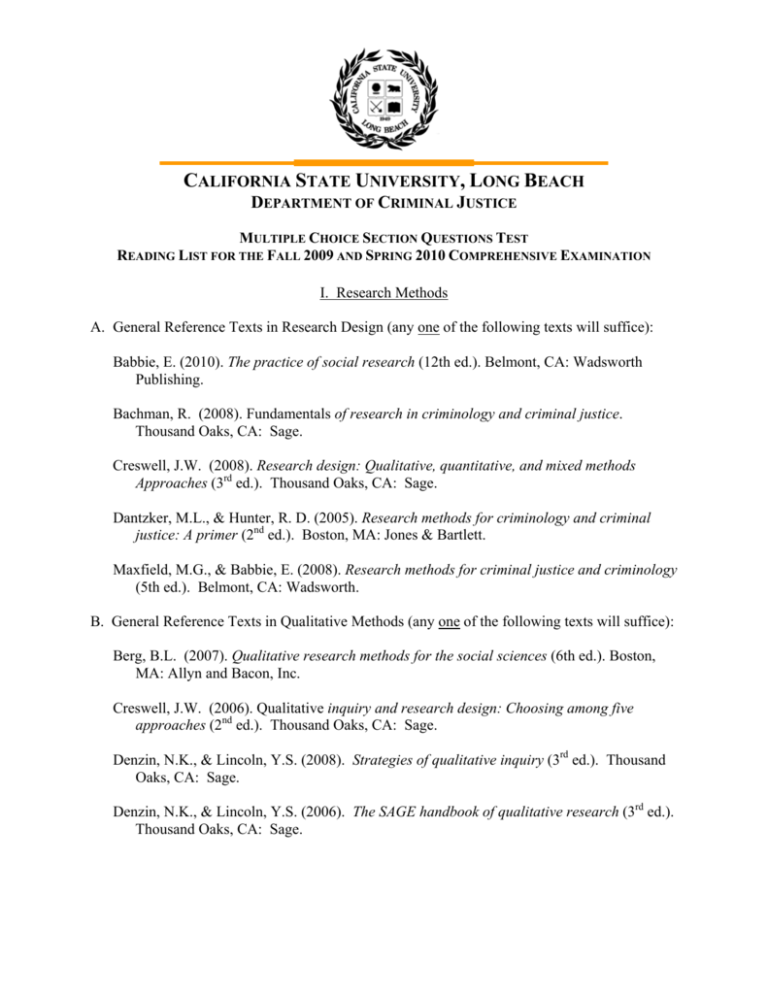
CALIFORNIA STATE UNIVERSITY, LONG BEACH DEPARTMENT OF CRIMINAL JUSTICE MULTIPLE CHOICE SECTION QUESTIONS TEST READING LIST FOR THE FALL 2009 AND SPRING 2010 COMPREHENSIVE EXAMINATION I. Research Methods A. General Reference Texts in Research Design (any one of the following texts will suffice): Babbie, E. (2010). The practice of social research (12th ed.). Belmont, CA: Wadsworth Publishing. Bachman, R. (2008). Fundamentals of research in criminology and criminal justice. Thousand Oaks, CA: Sage. Creswell, J.W. (2008). Research design: Qualitative, quantitative, and mixed methods Approaches (3rd ed.). Thousand Oaks, CA: Sage. Dantzker, M.L., & Hunter, R. D. (2005). Research methods for criminology and criminal justice: A primer (2nd ed.). Boston, MA: Jones & Bartlett. Maxfield, M.G., & Babbie, E. (2008). Research methods for criminal justice and criminology (5th ed.). Belmont, CA: Wadsworth. B. General Reference Texts in Qualitative Methods (any one of the following texts will suffice): Berg, B.L. (2007). Qualitative research methods for the social sciences (6th ed.). Boston, MA: Allyn and Bacon, Inc. Creswell, J.W. (2006). Qualitative inquiry and research design: Choosing among five approaches (2nd ed.). Thousand Oaks, CA: Sage. Denzin, N.K., & Lincoln, Y.S. (2008). Strategies of qualitative inquiry (3rd ed.). Thousand Oaks, CA: Sage. Denzin, N.K., & Lincoln, Y.S. (2006). The SAGE handbook of qualitative research (3rd ed.). Thousand Oaks, CA: Sage. C. Required Article: Kleck, G., Tark, J., & Bellows, J.J. (2006). What methods are most frequently used in research in criminology and criminal justice? Journal of Criminal Justice, 34(2), 147152. II. Applied, Social-Scientific Statistics General Reference Texts (any one of the following texts will suffice): Frankfort-Nachmias, C. (2008). Social statistics for a diverse society (5th ed.). Thousand Oaks, CA: Sage. Miethe, T.D., (2007). Simple statistics: Applications in criminology and criminal justice. Los Angeles: Roxbury Publishing. Jackson, S.L. (2005). Statistics: Plain and simple. Belmont, CA.: Wadsworth Publishing. Salkind, N. J. (2006). Statistics for people who (think they) hate statistics. (3rd ed.). Thousand Oaks, CA: Sage. III. Criminological Theory A. Required Readings: Cullen, F.T. & Agnew, R. (2006). Criminological theory, past to preset: Essential readings. (3rd ed.). New York, NY: Oxford University Press. Crutchfield, R.D., Kubrin, E.E, Bridges, G.S., & Weis, J.G. (2008). Crime: Readings. (3rd ed.). Thousand Oaks, CA: Sage. B. General Reference Texts (any one of the following texts will suffice): Bohm, R.M. (2001). Primer on crime and delinquency theory (2nd ed.). Belmont, CA: Wadsworth. Brown, S.E., Esbensen, F.A. & Geis, G. (2006). Criminology: Explaining crime and its context (6th ed.). Cincinnati, OH: Anderson Pub Co./Lexis-Nexis. Hagan, F.E. (2007). Introduction to criminology: Theories, methods, and criminal behavior (6th ed.). Thousand Oaks, CA: Sage. Lilly, J.R., Cullen, F.T. & Ball, R.A. (2006). Criminological theory: Context and consequences (4th ed.). Thousand Oaks, CA: Sage. Miller, M., Schreck, C. & Tewksburg, R. (2008). Criminological theory: A brief introduction. Boston, MA: Allyn and Bacon. Siegel, L.J. (2007). Criminology: The core. Belmont, CA: Wadsworth Publishing Company. C. Other Important Readings: Note: You should be familiar with the authors listed below and the major ideas contained in the sources cited. Most of these readings are discussed in the required text by Cullen & Agnew; others are available either online or through our library. Akers, R. L. (1998). Social learning and social structure: A general theory of crime and deviance. Boston, MA: Northeastern University Press. Andenaes, J. (1974). Punishment and deterrence. Ann Arbor, MI: University of Michigan Press. Antonaccio, O., & Tittle, C.R. (2008). Morality, self-control, and crime. Criminology, 46(2), 479-510. Beccaria, C. (1963). On crimes and punishments (H. Paolucci, Trans.). Indianapolis, IN: Bobbs-Merrill. (Original work published 1764). Available online at: http://www.crimetheory.com/Archive/Beccaria/index.html Becker, H.S. (1963). Outsiders: Studies in the sociology of deviance. New York, NY: The Free Press. Bentham, J. (1781). An introduction to the principles of morals and legislation. Available online at: http://www.utilitarianism.com/jeremy-bentham/index.html#thirteen Burgess, R.L. & Akers, R.L. (1966). A differential association-reinforcement theory of criminal behavior. Social Problems, 14, 128-147. Braithwaite, J. (1989). Crime, shame and reintegration. Cambridge, UK: Cambridge University Press. Chambliss, W.J. (1964). A sociological analysis of the law of vagrancy. Social Problems, 12, 67-77. Chesney-Lind, M. (1981). Girls, crime, and women’s place: Towards a feminist model of female delinquency. Crime and Delinquency, 35, 5-29. Cloward, R.A. & Ohlin, L.E. (1960). Delinquency and opportunity: A theory of delinquent gangs. New York, NY: The Free Press. 3 Cohen, L.E. & Felson, M. (1979). Social change and crime: A routine activity approach. American Sociological Review, 44, 588-608. Daly, K. (1997). Different ways of conceptualizing sex/gender in feminist theory and the implications for criminology. Theoretical Criminology, 1(1), 25-51. Dugdale, R. (1877). The Jukes: A study in crime, pauperism, and heredity. New York, NY: G.P. Putnam’s and Sons/The Knickerbocker Press. Durkheim, É. (1982). Rules for the explanation of social facts. In W.D. Halls (Trans.) The rules of the sociological method. New York: The Free Press. (Oringinal published in 1895). Available online at: http://varenne.tc.columbia.edu/bib/texts/durkheim_rules_chap5.html Farrington, D. P. (1995). The development of offending and antisocial behavior from childhood: Key findings from the Cambridge Study in Delinquent Development. Journal of Child Psychology and Psychiatry, 36(6), 929-964. Galton, F. (1909). Essays in eugenics. London, UK: Eugenics Education Society/ Goddard, H.H. (1914). Feeblemindedness: Its causes and consequences. New York, NY: The Macmillan Company. Glueck, S., & Glueck, E. (1956). Physique and delinquency. New York, NY: Harper and Brothers. Gottfredson, M. & Hirschii, T. (1990). A general theory of crime. Palo Alto, CA: Stanford University Press. Grasmick, H. G., & Bursik, R. J. (1990). Conscience, significant others, and rational choice: Extending the deterrence model. Law and Society Review, 24, 837-861. Hirschi, T. (1969). A control theory of delinquency. Berkeley, CA: University of California Press. Jeffery, C.R. (1978). Criminology as an interdisciplinary behavioral science. Criminology, 16, 147-169. Kessler, S. & Moors, R. (1970). The XYY karyotype of criminality: A review. Journal of Psychiatric Research, 7, 164. Lombroso, C. (1863). Criminal man. Turin, Italy: Fratelli Bocca. Merton, R.K. (1938). Social structure and anomie. American Sociological Review, 3, 67282. 4 Pratt, T.C., Cullen, F.T., Blevins, K.R., Daigle, L.E., & Madensen, T.D. (2006). The empirical status of deterrence theory: A meta-analysis. In F.T. Cullen, J.P. Wright, & K.R. Blevins (Eds.). Taking stock: The status of criminological theory. Piscataway, NJ: Transaction Publishers/Rutgers University Press. Quinney, R. (1977). Class, state, and crime. New York, NY: Longman. Rowe, D.C., & Farrington, D.P. (2007). Biology and crime (2nd ed.) New York, NY: Oxford University Press. Shaw, C.R., & McKay, H.D. (1942). Juvenile delinquency in urban areas. Chicago, IL: University of Chicago Press. Sutherland, E.H. (1945). Is 'white collar crime' crime?" American Sociological Review, 10( 2), 132-39. Sykes, G.M., & Matza, D. (1957). Techniques of neutralization: A theory of delinquency. American Sociological Review, 22, 664-70. Sykes, G.M. (1974). The rise of critical criminology. Journal of Criminal Law and Criminology, 65(2), 206-13. Tannenbaum, F. (1938). Crime and the community (The dramatization of evil). Boston, MA: Ginn and Co. Walsh, A. (2008). Biosocial criminology. London, UK: Routledge. Wilson, J.Q. & Hernstein, R.J. (1985). Crime and human nature. New York: Simon and Schuster. Wilson, J.Q., & Kelling, G.L. (1982, March). Broken windows: The police and neighborhood safety. Atlantic Monthly, 29-38. Available online at: http://www.theatlantic.com/doc/198203/broken-windows Wolfgang, M.E. (1958). Patterns in criminal homicide. Montclair, NJ: Patterson Smith. 5
